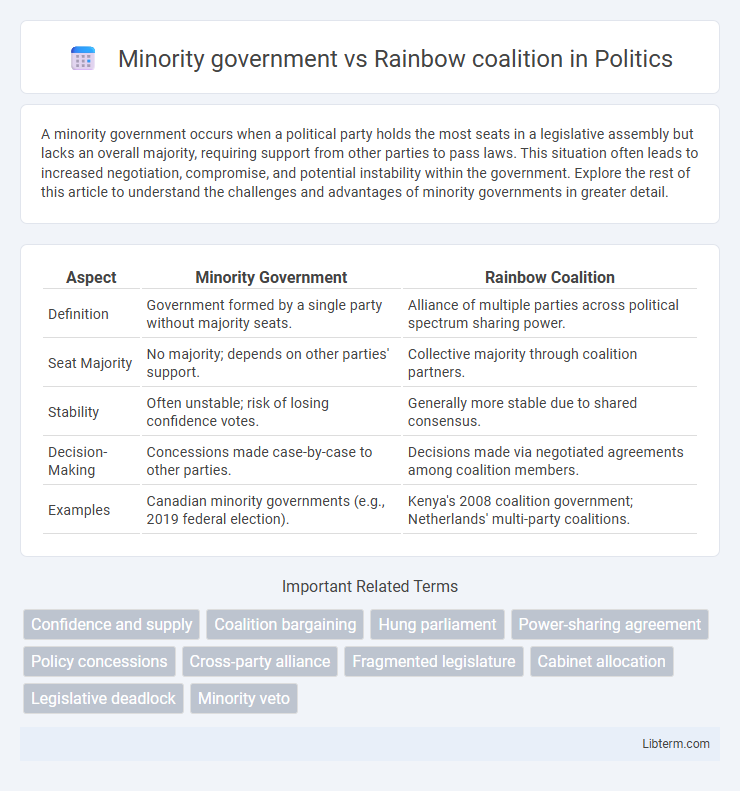A minority government occurs when a political party holds the most seats in a legislative assembly but lacks an overall majority, requiring support from other parties to pass laws. This situation often leads to increased negotiation, compromise, and potential instability within the government. Explore the rest of this article to understand the challenges and advantages of minority governments in greater detail.
Table of Comparison
| Aspect | Minority Government | Rainbow Coalition |
|---|---|---|
| Definition | Government formed by a single party without majority seats. | Alliance of multiple parties across political spectrum sharing power. |
| Seat Majority | No majority; depends on other parties' support. | Collective majority through coalition partners. |
| Stability | Often unstable; risk of losing confidence votes. | Generally more stable due to shared consensus. |
| Decision-Making | Concessions made case-by-case to other parties. | Decisions made via negotiated agreements among coalition members. |
| Examples | Canadian minority governments (e.g., 2019 federal election). | Kenya's 2008 coalition government; Netherlands' multi-party coalitions. |
Introduction: Defining Minority Governments and Rainbow Coalitions
Minority governments occur when a single party governs without a majority of seats, relying on support from other parties to pass legislation. Rainbow coalitions represent alliances comprising multiple parties with diverse political ideologies united to form a majority government. Understanding these frameworks is essential for analyzing parliamentary dynamics and the negotiation processes within multi-party systems.
Formation Processes: How Each Government Type Emerges
Minority governments form when no single party attains a majority in the legislature, leading the largest party to govern alone while relying on issue-by-issue support from others to pass legislation. Rainbow coalitions emerge through negotiated alliances among multiple diverse parties, often spanning a broad ideological spectrum, to collectively achieve a governing majority. The formation of minority governments typically revolves around maintaining flexible agreements, whereas rainbow coalitions require formalized power-sharing arrangements and consensus-building across parties.
Power Dynamics and Decision-Making Structures
Minority governments rely on one party without an absolute majority, necessitating negotiation with other parties to pass legislation, often resulting in limited power and unstable decision-making. Rainbow coalitions comprise multiple parties united across diverse ideologies, sharing power through agreed structures that promote collective decision-making and more inclusive governance. The power dynamics in minority governments favor the largest party navigating external support, whereas rainbow coalitions distribute authority among partners, balancing influence to maintain cohesion and policy stability.
Stability and Durability: Which Model Prevails?
Minority governments often struggle with stability due to their reliance on ad hoc support from other parties, leading to frequent policy gridlocks and shorter lifespans. Rainbow coalitions, while more inclusive and representative, face challenges in durability because their diverse composition can result in internal conflicts and fragile consensus-building. Empirical studies show that durable governance tends to emerge from coalitions with aligned policy objectives, suggesting that the success of either model depends heavily on political context and coalition management strategies.
Policy Outcomes: Effectiveness and Efficiency Compared
Minority governments often face challenges in passing legislation, leading to slower policy outcomes but greater negotiation and compromise, which can enhance policy inclusiveness. Rainbow coalitions, composed of multiple parties with diverse agendas, may produce more comprehensive policies but risk inefficiency due to complex decision-making and maintaining unity. Studies indicate that minority governments tend to deliver more focused and timely policies, while rainbow coalitions offer broader representation at the cost of policy coherence.
Representation and Inclusivity in Governance
Minority governments often struggle with limited representation, as they lack a parliamentary majority and must rely on opposition support, potentially marginalizing smaller groups. Rainbow coalitions, composed of multiple diverse parties, enhance inclusivity by integrating varied social, ethnic, and political interests into governance. This coalition model promotes broader representation, ensuring minority voices influence policy-making and decision processes more effectively.
Negotiation and Compromise: Managing Diverse Interests
Minority governments rely heavily on negotiation with opposition parties to pass legislation, often requiring tailored compromises to gain essential support while maintaining policy priorities. Rainbow coalitions unite multiple parties with varied ideologies, necessitating continuous dialogue and flexible agreements to balance diverse interests and foster collective decision-making. Both systems depend on strategic negotiation skills to achieve stability and implement effective governance amid competing political agendas.
Historical Examples and Case Studies
The United Kingdom's minority government under Theresa May in 2017 relied on a confidence-and-supply agreement with the Democratic Unionist Party, reflecting challenges in passing legislation without an outright majority. In contrast, Belgium's rainbow coalition governments, such as the 2011-2014 administration, combined multiple political parties across linguistic and ideological lines to maintain stability in a fragmented parliamentary system. Case studies reveal minority governments often face legislative gridlock, whereas rainbow coalitions emphasize inclusivity and power-sharing among diverse party groups to sustain governance.
Public Perception and Political Legitimacy
Minority governments often face challenges in public perception due to perceived instability and limited mandate, affecting their political legitimacy. Rainbow coalitions, by uniting diverse parties, tend to enhance legitimacy through broader representation, though they may encounter skepticism over policy coherence. Voter trust in minority governments frequently hinges on effective negotiation, whereas rainbow coalitions rely on demonstrating inclusive governance to legitimize their authority.
Conclusion: Choosing the Right Model for Parliamentary Systems
Selecting between a minority government and a rainbow coalition depends on the political context and stability requirements within parliamentary systems. Minority governments offer flexibility but often face legislative challenges, while rainbow coalitions provide broader representation but may struggle with internal cohesion. Effective governance hinges on balancing party interests and ensuring consistent policy implementation to maintain democratic legitimacy and stability.
Minority government Infographic

 libterm.com
libterm.com